Folly

The Dunmore Pineapple in Scotland

Casino at Marino, Dublin, Ireland
In architecture, a folly is a building constructed primarily for decoration, but suggesting through its appearance some other purpose, or of such extravagant appearance that it transcends the range of garden ornaments usually associated with the class of buildings to which it belongs.
Eighteenth-century English landscape gardening and French landscape gardening often featured mock Roman temples, symbolising classical virtues. Other 18th-century garden follies represented Chinese temples, Egyptian pyramids, ruined abbeys, or Tatar tents, to represent different continents or historical eras. Sometimes they represented rustic villages, mills, and cottages to symbolise rural virtues.[1] Many follies, particularly during times of famine, such as the Irish potato famine, were built as a form of poor relief, to provide employment for peasants and unemployed artisans.
In English, the term began as “a popular name for any costly structure considered to have shown folly in the builder”, the OED‘s definition,[2] and were often named after the individual who commissioned or designed the project. The connotations of silliness or madness in this definition is in accord with the general meaning of the French word “folie”; however, another older meaning of this word is “delight” or “favourite abode”.[3] This sense included conventional, practical, buildings that were thought unduly large or expensive, such as Beckford’s Folly, an extremely expensive early Gothic Revival country house that collapsed under the weight of its tower in 1825, 12 years after completion. As a general term, “folly” is usually applied to a small building that appears to have no practical purpose or the purpose of which appears less important than its striking and unusual design, but the term is ultimately subjective, so a precise definition is not possible.
Characteristics
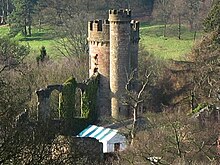
Hagley Castle is in the grounds of Hagley Hall. It was built by Sanderson Miller for George, Lord Lyttelton in the middle of the 18th century to look like a small ruined medieval castle.[4]
The concept of the folly is subjective and it has been suggested that the definition of a folly “lies in the eyes of the beholder”.[5] Typical characteristics include:
- They have no purpose other than as an ornament.[6] Often they have some of the appearance of a building constructed for a particular purpose, such as a castle or tower, but this appearance is a sham. Equally, if they have a purpose, it may be disguised.
- They are buildings, or parts of buildings.[6] Thus they are distinguished from other garden ornaments such as sculpture.
- They are purpose-built. Follies are deliberately built as ornaments.
- They are often eccentric in design or construction. This is not strictly necessary; however, it is common for these structures to call attention to themselves through unusual details or form.
- There is often an element of fakery in their construction. The canonical example of this is the sham ruin: a folly which pretends to be the remains of an old building but which was in fact constructed in that state.
- They were built or commissioned for pleasure.[6]
History
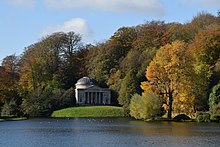
The Pantheon at Stourhead estate
Follies began as decorative accents on the great estates of the late 16th century and early 17th century but they flourished especially in the two centuries which followed. Many estates had ruins of monastic houses and (in Italy) Roman villas; others, lacking such buildings, constructed their own sham versions of these romanticstructures.
However, very few follies are completely without a practical purpose. Apart from their decorative aspect, many originally had a use which was lost later, such as hunting towers. Follies are misunderstood structures, according to The Folly Fellowship, a charity that exists to celebrate the history and splendour of these often neglected buildings.[citation needed]
Follies in 18th-century French and English gardens

The Temple of Philosophy at Ermenonville
Follies (French: fabriques) were an important feature of the English garden and French landscape garden in the 18th century, such as Stowe and Stourhead in England and Ermenonville and the gardens of Versailles in France. They were usually in the form of Roman temples, ruined Gothic abbeys, or Egyptian pyramids. Painshill Park in Surrey contained almost a full set, with a large Gothic tower and various other Gothic buildings, a Roman temple, a hermit’s retreat with resident hermit, a Turkish tent, a shell-encrusted water grotto and other features. In France they sometimes took the form of romantic farmhouses, mills and cottages, as in Marie Antoinette‘s Hameau de la Reine at Versailles. Sometimes they were copied from landscape paintings by painters such as Claude Lorrainand Hubert Robert. Often, they had symbolic importance, illustrating the virtues of ancient Rome, or the virtues of country life. The temple of philosophy at Ermenonville, left unfinished,[7] symbolised that knowledge would never be complete,[clarification needed] while the temple of modern virtues at Stowe was deliberately ruined, to show the decay of contemporary morals.[citation needed]
Later in the 18th century, the follies became more exotic, representing other parts of the world, including Chinese pagodas, Japanese bridges, and Tatar tents.[8]
Famine follies
The Irish Potato Famine of 1845–49 led to the building of several follies in order to provide relief to the poor without robbing them of their dignity by issuing unconditional handouts. However, to hire the needy for work on useful projects would deprive existing workers of their jobs. Thus, construction projects termed “famine follies” came to be built. These included roads in the middle of nowhere, between two seemingly random points, screen and estate walls, piers in the middle of bogs, etc.[9]
Examples
Follies are found worldwide, but they are particularly abundant in Great Britain.[10]
Austria

Roman ruin, Schönbrunn, Austria

Small Gloriette of Schönbrunn Palace
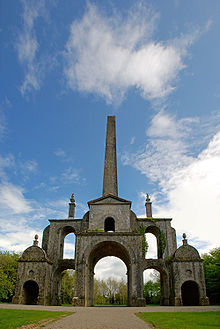
Conolly’s Folly, County Kildare, Ireland, built to provide employment in the Irish famine of 1740–41
- Roman ruin and gloriettes, in the park of Schönbrunn Palace, Vienna
Czech Republic
- Series of buildings in Lednice–Valtice Cultural Landscape
France
- Chanteloup Pagoda, near Amboise
- Désert de Retz, folly garden in Chambourcy near Paris, France (18th century)
- Palais idéal, Facteur Cheval‘s folly in Hauterives
- Parc de la Villette in Paris has a number of modern follies by architect Bernard Tschumi.
- Ferdinand Cheval in Châteauneuf-de-Galaure, built what he called an Ideal Palace, seen as an example of naive architecture.
- Hameau de la Reine, in the park of the Château de Versailles
Germany
- Bergpark Wilhelmshöhe water features
- Lighthouse in the park of Moritzburg Castle near Dresden
- Mosque in the Schwetzingen Castle gardens
- Pfaueninsel artificial ruin, Berlin
- Ruinenberg near Sanssouci Park, Potsdam
Hungary
- Bory Castle at Székesfehérvár
- Taródi Castle at Sopron
- Vajdahunyad vára in the City Park of Budapest
India
Ireland
- Carden’s Folly
- Casino at Marino[citation needed]
- Conolly’s Folly and The Wonderful Barn on the same estate
- Killiney Hill, with several follies
- Larchill in County Kildare, with several follies
- Powerscourt Estate, which contains the Pepperpot Tower
- Saint Anne’s Park, which contains a number of follies
- Saint Enda’s Park, former school of Patrick Pearse, contains several follies
- The Jealous Wall at Belvedere House near Mullingar, Co. Westmeath
Italy
- La Scarzuola, Montegabbione
- The Park of the Monsters (Bomarzo Gardens)
- Il Giardino dei Tarocchi near Capalbio
Malta[
Poland
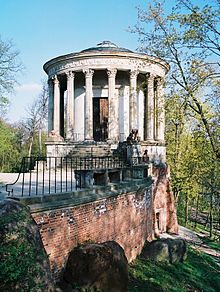
Temple of the Sibyl in the grounds of the Czartoryski Palace in Puławy, Poland
- Roman aqueduct, Arkadia, Łowicz County
- Temple of the Sibyl in Puławy
Russia
- Ruined towers in Peterhof, Tsarskoe Selo, Gatchina, and Tsaritsino
- Creaking Pagoda and Chinese Village in Tsarskoe Selo
- Dutch Admiralty in Tsarskoe Selo
Ukraine

Classical ruins in Oleksandriia Park in Bila Tserkva, Ukraine
- Ruins in Oleksandriia, Bila Tserkva
United Kingdom

Rushton Triangular Lodge, Northamptonshire, England, built in the late 16th century to symbolise the Holy Trinity
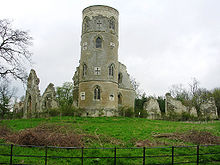
Wimpole’s Folly, Cambridgeshire, England, built in the 1700s to resemble Gothic-era ruins
The Beacon: One of the remaining follies at Staunton Country Park originally commissioned by George Thomas Staunton and designed by Lewis Vulliamy

Gothic temple at Stowe Park, Buckinghamshire
England
- Ashton Memorial, Lancaster
- Beckford’s Tower, Somerset
- Broadway Tower, The Cotswolds
- Bettison’s Folly, Hornsea
- Black Castle Public House, Bristol
- Brizlee Tower, Northumberland
- The Cage at Lyme Park, Cheshire
- The Castle at Roundhay Park, West Yorkshire
- Clavell Tower, Dorset
- Faringdon Folly, Faringdon, Oxfordshire
- Flounders’ Folly, Shropshire
- Forbidden Corner, North Yorkshire
- Freston Tower, near Ipswich, Suffolk
- Garrick’s Temple to Shakespeare, Hampton
- Gothic Tower at Goldney Hall, Bristol
- The Great Pagoda at the Royal Botanic Gardens, Kew, London¨
- Hadlow Tower, Hadlow, Kent
- Hardwick Hall Country Park, County Durham contains several restored follies
- Hawkstone Park, follies and gardens in Shropshire
- Hiorne’s Tower, Arundel Castle, West Sussex
- Horton Tower, Dorset
- King Alfred’s Tower, Stourhead, Somerset
- Mow Cop Castle, Staffordshire
- Old John, Bradgate Park, Leicestershire
- Painshill, Cobham, Surrey, an 18th-century landscape garden with several follies, some modern reconstructions
- Penshaw Monument, Penshaw, Sunderland
- Pelham’s Pillar, Caistor, North Lincolnshire
- Perrott’s Folly, Birmingham
- Pope’s Grotto, Twickenham, South West London
- Racton Monument, West Sussex
- The Ruined Arch at the Royal Botanic Gardens, Kew, London
- Rushton Triangular Lodge, Northamptonshire (16th century)
- Severndroog Castle, Shooter’s Hill, south-east London
- Sham Castle, Bathwick Hill, Bath, Somerset[11]
- The Sledmere Cross takes the form of an Eleanor Cross and is a true ‘folly’ that was ‘converted’ to a World War I Memorial
- Solomon’s Temple, Buxton, Derbyshire
- Stainborough Castle, South Yorkshire
- Two of the follies in Staunton Country Park have survived until the present day
- Stowe School has several follies in the grounds
- Sway Tower, New Forest
- Tattingstone Wonder, near Ipswich, Suffolk
- Wainhouse Tower, the tallest folly in the world, Halifax, West Yorkshire
- Wentworth Woodhouse, Wentworth, South Yorkshire
- Williamson Tunnels, probably the largest underground folly in the world, Liverpool
- Wilder’s Folly, Sulham, Berkshire
Scotland
- The Caldwell Tower, Lugton, Renfrewshire
- Captain Frasers Folly (Uig Tower) Isle of Skye
- Dunmore Pineapple, Falkirk
- Hume Castle, Berwickshire
- Kinnoull Hill Tower, Perth
- McCaig’s Tower, Oban, Argyll and Bute
- National Monument, Edinburgh
- The Temple near Castle Semple Loch, Renfrewshire
Wales

Paxton’s Tower, Carmarthenshire
- Castell Coch, Cardiff
- Clytha Castle, Monmouthshire
- Folly Tower at Pontypool
- Paxton’s Tower, Carmarthenshire
- Portmeirion
United States
- Bancroft Tower, Worcester, Massachusetts
- Belvedere Castle, New York City
- Bishop Castle, outside of Pueblo, Colorado
- Chateau Laroche, Loveland, Ohio
- Italian Barge, Villa Vizcaya, Miami, Florida
- Kingfisher Tower, Otsego Lake (New York)
- Lawson Tower, Scituate, Massachusetts
- Coral Castle, Homestead, Florida
- Summersville Lake Lighthouse, Mount Nebo, West Virginia
- The Parthenon in Nashville, Tennessee
- Hofmann Tower in Lyons, Illinois
- Vessel_(structure), New York, New York
See also

Palais idéal – Hauterives, France



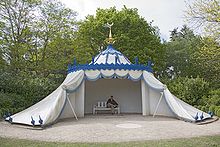





More Stories
Poorest Region of America – What It Really Looks Like 🇺🇸 by Peter Santenello
15 Mysteries and Secrets of Mount Kailash (More than a Sacred Mountain)
The Chicago River Tour with Geoffrey Baer